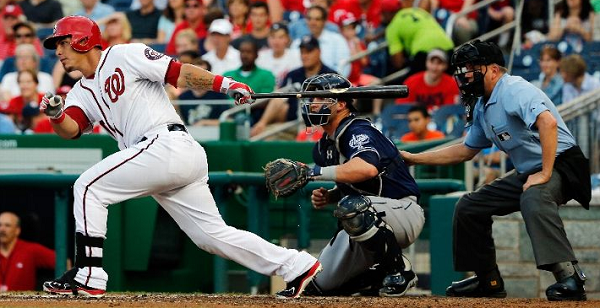You’d be forgiven if, before this season started, you were concerned with the Nationals’ catching situation, and really wanted them to address it. At least I’d forgive you, because I certainly felt that way.
In 2014 and 2015, Wilson Ramos managed a sub-100 OPS+ and wRC+, hitting below league average. 2015 was especially tough for him. But he wasn’t always that bad.
From 2011-2013 he hit a very respectable .269/.327/.449. He was a promising young hitter, then it seemed to all go away. Until this year.
To say he has hit well this season is an understatement. He leads all catchers in wRC+, wOBA, TAv, OPS… pretty much all of those advanced rate hitting stats. But he’s also third in the entire NL in wRC+ and wOBA.
There is no doubt this improved hitting has something to do with his Lasik surgery, and that can be credited for him emerging from his two year funk. But if it was simply a buffalo getting his mojo (and eyesight) back, he’d probably look like the guy from a few years ago. But he doesn’t.
Instead, he’s sitting at a career low K rate of 11.7% (his previous best rate was in 13.9% in 2013). His walk rate is a bit above his career average but he’s had higher rates. He is hitting more HR per PA than most of his good years, but not by much. He has, however, really poured on the extra base hits at a much higher rate than he ever has.
It’s not all good news, though. His batting average is sitting at an unsustainable .350, almost 90 points higher than his career average. His BABIP of .364 reinforces that in some ways – but that number might be more than the “luck” side of the BABIP coin. He might be hitting the ball really hard, harder than he did before.
We don’t have batted ball speed data prior to 2015, but there wasn’t difference between most pitches, between this year and last year anyway. Although he was killing offspeed stuff in comparison, this is on the back of 9 pitches actually being put into play, so we can probably ignore it.
What’s more interesting to me, though, is how the ball is coming off the bat. I’m not talking about his spray angle per se, more the results. He is hitting more line drives than he ever has, hitting fewer ground balls than he has since 2011, and keeping his fly ball rate down to near career lows.
The fly balls that he has hit are going out of the park at rates that are similar to his best seasons, but the biggest difference is the additional line drives. That BABIP is high not because he’s hitting it between infielders, it’s because he’s hitting line drives.
In other words, compared to the 2011-2013 Ramos, 2016 Ramos is mostly the same except he’s striking out less, and hitting more line drives.
LASIK is an easy explanation, but he gets an annual eye exam, so it’s hard to believe he couldn’t see back in 2011. Luck certainly has a bit to do with his success, but it’s also not the only factor.
Looking at his batting stance, it seems to be pretty close this season to what it was back in 2013. He starts with an open stance and steps towards the plate, his bat is elevated and bopping. The only difference I notice was he appears a bit to be a bit more upright now, he was leaning forward a bit more back then.
So, with all that, we still haven’t figured out why he has improved so much over 2011-2013. The batting stance isn’t terribly different, but maybe there was a tweak there.
But there’s one more thing that we didn’t mention, and that’s his age. At 28, Ramos is at the age that most players are in their prime. It could be maturity, just understanding better how to hit. Even though his swing hasn’t changed much at all, perhaps his approach has.
Maybe there isn’t one key to Ramos’ success. Maybe what we’re seeing is improvement from a guy who is finally really healthy, can see well again, made a few minor tweaks, and improved his approach. The combination of all of those things might be why Ramos is now one of the best hitters in the NL.

